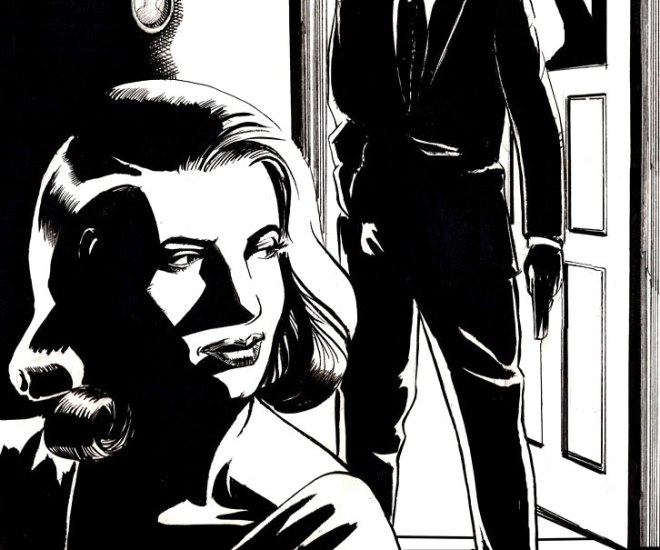
My wife, Jessica, enrolled in a “Detective Lit” course some seventeen years ago now. Our marriage was so new at that time she could have returned me and received a full refund. But, to my continual delight, she instead concentrated her efforts on finishing off her bachelor’s degree so we might then earn glorious amounts of money and never hit so much as a speed bump for the rest of our lives. Jess loved the course and took enough notes to prove it. The course was not exhaustive, but covered the early greats of the genre–Dashiell Hammett, Raymond Chandler, and Ross MacDonald. I had read a mystery here and there, mostly Sherlock Holmes and Encyclopedia Brown, but had never read any story populated by icy blondes, a revolver in their garter belts, or men dressed in well-cut serge suits, with hard eyes and wine-red ties, before in my life. Then, as soon as Jess put a book down, I picked it up to dog-ear it all over again.
The style, Chandler’s particularly, grabbed me. Loose, witty, and sometimes whimsical, all the while characters talked over the corpses of dead men, it seemed effortless and fun; a casual way to speak about sordid matters without losing your sense of humor. Chandler wrote of
“Hammett’s style at its worst was as formalized as a page of Marius the Epicurean; at its best it could say almost anything. I believe this style, which does not belong to Hammett or to anybody, but is the American Language (and not even exclusively that any more), can say things he did not know how to say, or feel the need of saying.”
And, indeed, every sentence dazzled me with novelty.
The stories, too, seemed to live in their own reality (maybe a less fanciful reality had I read this fiction out of a 1930s printing of Black Mask magazine) and the people in them seemed to live lives larger than their duty to the plot. In Raymond Chandler’s essay The Simple Art of Murder, published in 1944, he runs through the formalization of the mystery genre, pithily fencing in the land it always had to graze.
“…fundamentally it is the same careful grouping of suspects, the same utterly incomprehensible trick of how somebody stabbed Mrs. Pottington Postlethwaite III with the solid platinum poniard just as she flatted on the top note of the “Bell Song” from Lakme in the presence of fifteen ill-assorted guests; the same ingenue in fur-trimmed pajamas screaming in the night to make the company pop in and out of doors and bull up the timetable; the same moody silence next day as they sit around sipping Singapore slings and sneering at each other, while the flatfeet crawl to and fro under the Persian rugs, with their derby hats on.”
The formal problem, usually presented as murder, was really beside the point. Hammett’s Sam Spade, Chandler’s Philip Marlowe, or MacDonald’s Lew Archer spent most their time negotiating the psychology of the man or woman standing in front of them, who likely held or concealed a gun and attempted to either intimidate them or tempt them. Mystery novels, love them, answer all their own questions. The detective story, on the other hand, was something entirely new to me; rarely answering anything succinctly and always leaving overlapping penumbras lingering in my mind.
We keep these books, the originals Jess bought for the course and additions, in a box. I get a hankering around the end of Spring/beginning of Summer for a good detective book, so I dig these literal gems out to read again. I always start by rereading Chandler’s essay on the genre and then shuffle through the volumes to sample the flavors of each writer. Do I want to start with the brute efficiency of Hammett’s prose? Or, the deadpan, slow burn of Raymond Chandler’s wisecracking charm other writers frequently strain to imitate? Or, Ross MacDonald, staring into the philosophical depths of Lew Archer’s soul while he punches a chisler in the gut for pulling a switchblade on him?
Whatever I decide, you should pick one of these books up because not only is it about crime and honor, a principled man standing against a society gone to seed, but its literary art. And as Raymond Chandler wrote:
“In everything that can be called art there is a quality of redemption.”

[…] myself quit awhile with the opportunity to write/draw a noir-ish detective story like so many of my favorite writers. My character, Rick O’Shea (a horrible homonym that I enjoy all the same), is my detective […]